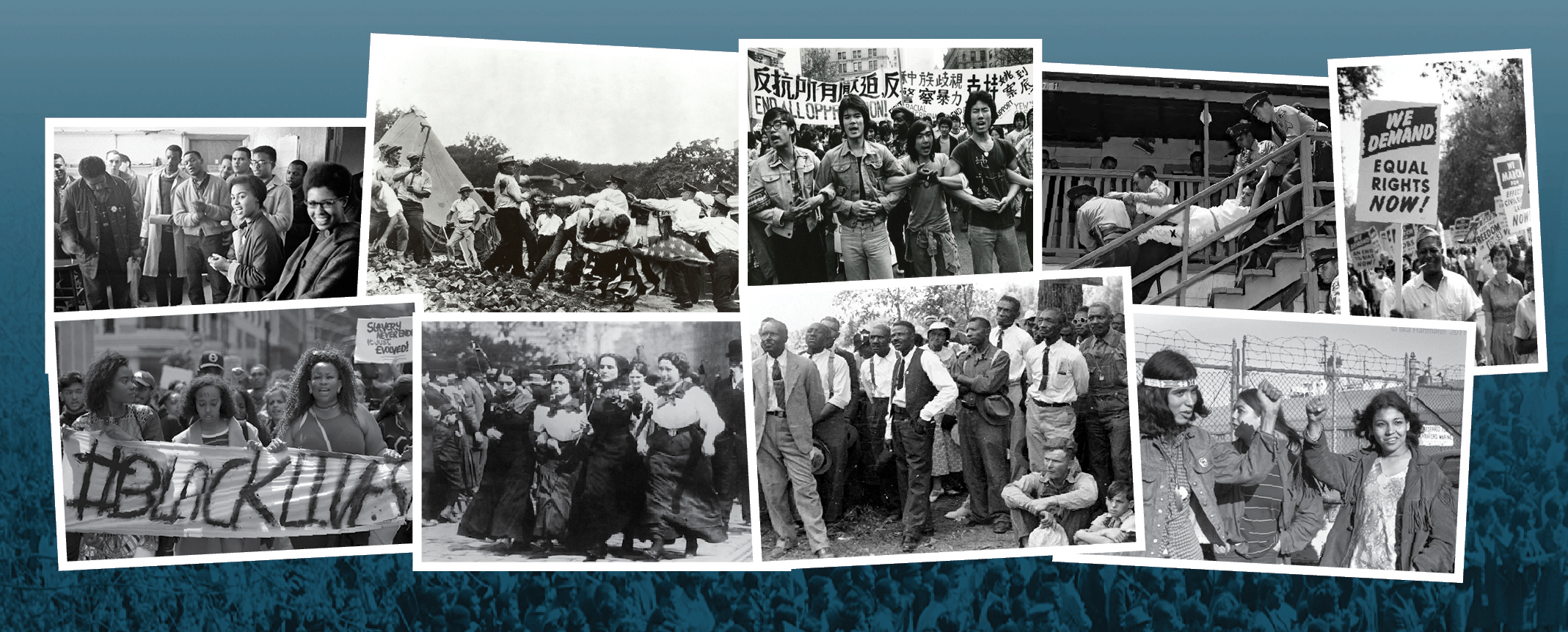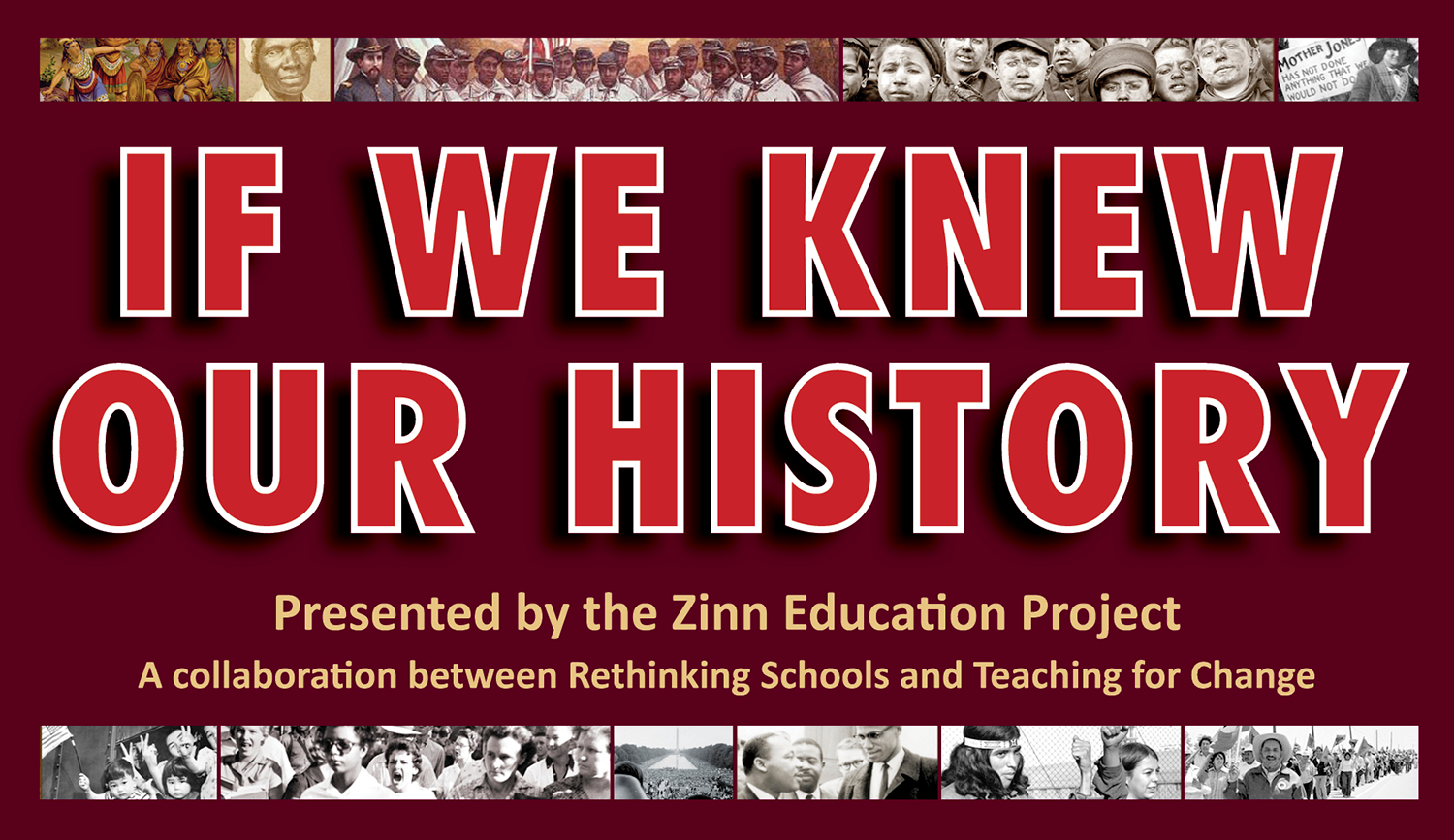
These questions are about some of the history omitted or misrepresented in textbooks. You may have already responded to this quiz in the young readers’ edition of The Rebellious Life of Mrs. Rosa Parks insert. If so, scroll to the answers. If not, respond to the questions first and then check your responses.
1. During which period in U.S. history was the public education system first established in the South?
A. The Colonial Era
B. Reconstruction
C. Civil Rights Movement
2. How many U.S. presidents held people in bondage (slavery)?
A. 3
B. 8
C. 12
D. 15
3. During the Irish Potato Famine, large quantities of meat were exported from Ireland to England.
A. True
B. False
4. Before Rosa Parks, Claudette Colvin, and others in 1955, how many African Americans protested inequality on public transportation in the 19th and 20th centuries?
A. 6
B. 53
C. 124
D. More than 1,000
5. What was the Red Scare, including McCarthyism, designed to target?
6. Where was the largest demonstration during the modern Civil Rights Movement?
A. Birmingham
B. New York City
C. Atlanta
D. St. Louis
7. When on trial for civil disobedience to stop the extraction of fossil fuels, some environmental activists have used the “necessity defense.” What do you think the “necessity defense” is?
8. Dr. Martin Luther King Jr. was killed in 1968, exactly one year to the day after he gave a speech on:
A. voting rights.
B. school integration.
C. fair housing.
D. the Vietnam War.
9. In 2016, the Standing Rock Sioux, joined by members of more than 200 other Native American tribes, began a protest of the Dakota Access Pipeline. Why?
10. What role did the Federal Bureau of Investigation (FBI) most consistently play with regards to the Civil Rights Movement?
A. They protected African Americans who pursued their constitutional right to vote, attend school, use public transportation, pray, and more.
B. They collected information, spied on civil rights leaders (including Martin Luther King Jr.), and spread misinformation.
C. They collected information on the Ku Klux Klan and the American Nazi Party to prevent attacks on Civil Rights Movement activists.
D. None at all.
Check your answers and learn more.
1. During which period in U.S. history was the public education system first established in the South?
A. The Colonial Era
B. Reconstruction
C. Civil Rights Movement
Explanation: Prior to the Reconstruction Era, no Southern state had a state-financed public education system, even for whites. Public schools were established by interracial governments in the Reconstruction era state Constitutions. For example, Alabama’s new constitution established a centralized Board of Education and mandated that schools receive 20 percent of state revenue. By 1871, nearly 55,000 African American and 87,000 white children were attending public schools. Read more about the Reconstruction era.
2. How many U.S. presidents held people in bondage (slavery)?
A. 3
B. 8
C. 12
D. 15
Explanation: More than one in four U.S. presidents were involved in human trafficking and slavery. These presidents bought, sold, and bred enslaved people for profit. Of the 12 presidents who were enslavers, more than half kept people in bondage at the White House. For this reason, there is little doubt that the first person of African descent to enter the White House—or the presidential homes used in New York (1788–90) and Philadelphia (1790–1800) before construction of the White House was complete — was an enslaved person. Continue reading in Missing from Presidents’ Day: The People They Enslaved by Clarence Lusane.
3. During the Irish Potato Famine, large quantities of meat were exported from Ireland to England.
A. True
B. False
Explanation: During the first winter of famine, 1846–47, as perhaps 400,000 Irish peasants starved, landlords exported 17 million pounds sterling worth of grain, cattle, pigs, flour, eggs, and poultry — food that could have prevented those deaths. Read more in The Real Irish American Story Not Taught in Schools by Bill Bigelow.
4. Before Rosa Parks, Claudette Colvin, and others in 1955, how many African Americans protested inequality on public transportation in the 19th and 20th centuries?
A. 6
B. 53
C. 124
D. More than 1,000
Explanation: The struggle for the desegregation of transportation has a long history in the United States. Check out a timeline with dozens of examples dating back to 1841 — and there are more than one thousand more.
5. What was the Red Scare, including McCarthyism, designed to target?
Explanation: Powerful politicians manufacture threats and whip up fear to neutralize progressive challenges to the status quo — the McCarthy Era being a well-known high-water mark of state repression. During them, McCarthy era the targets were African American organizer for human, labor, and civil rights; LGBTQ organizers; labor activists of all races and ethnicities; and more.
6. Where was the largest demonstration during the modern Civil Rights Movement?
A. Birmingham
B. New York City
C. Atlanta
D. St. Louis
Explanation: On Monday, Feb. 3, 1964, 464,000 New York City school children — almost half of the city’s student body — boycotted school as part of a protest against school segregation. This was one of the largest Civil Rights Movement demonstrations. Continue reading.
7. When on trial for civil disobedience to stop the extraction of fossil fuels, some environmental activists have used the “necessity defense.” What do you think the “necessity defense” is?
Explanation: Arrested and charged with trespassing, sabotage, burglary, criminal mischief, and other “critical energy infrastructure” crimes, some environmental activists use the “necessity defense,” a legal approach that does not deny the defendant’s criminal action, but argues that it was carried out in order to prevent a greater harm — in this case, the continued extraction and burning of fossil fuels that is warming the climate and wreaking catastrophic damage to all forms of life. Read more.
8. Dr. Martin Luther King Jr. was killed in 1968, exactly one year to the day after he gave a speech on:
A. voting rights.
B. school integration.
C. fair housing.
D. the Vietnam War.
Explanation: On April 4, 1967, exactly one year before his assassination, Martin Luther King Jr. delivered a speech in New York City on the occasion of his becoming co-chairperson of Clergy and Laymen Concerned About Vietnam (subsequently renamed Clergy and Laity Concerned). Titled “Beyond Vietnam,” it was his first major speech on the war in Vietnam—what the Vietnamese aptly call the American War. King linked the escalating U.S. commitment to that war with its abandonment of the commitment to social justice at home. His call for a “shift from a ‘thing-oriented’ society to a ‘person-oriented’ society” and for us to “struggle for a new world” has acquired even greater urgency than when he issued it decades ago.
The speech concludes:
Our only hope today lies in our ability to recapture the revolutionary spirit and go out into a sometimes hostile world declaring eternal hostility to poverty, racism, and militarism. With this powerful commitment we shall boldly challenge the status quo and unjust mores and thereby speed the day when “every valley shall be exalted, and every mountain and hill shall be made low, and the crooked shall be made straight and the rough places plain …” Now let us begin. Now let us rededicate ourselves to the long and bitter — but beautiful — struggle for a new world. [This description is from a Rethinking Schools article posted on the Zinn Education Project website.]
9. In 2016, the Standing Rock Sioux, joined by members of more than 200 other Native American tribes, began a protest of the Dakota Access Pipeline. Why?
Explanation: On April 1, 2016, one of the greatest organizing efforts to protect land, human rights, and the future of this planet began in North Dakota. As described in the DAPL Fact Zine,
The protest it designed to stop the Dakota Access pipeline, the dangers associated with pipeline spills and the necessity to protect the water resources of the Missouri river. The Dakota Access Pipeline (DAPL) is proposed to transport 450,000 barrels per day of Bakken crude oil (which is fracked and highly volatile) from the lands of North Dakota to Patoka, Illinois. The threats this pipeline poses to the environment, human health and human rights are strikingly similar to those posed by the Keystone XL. Because the DAPL will cross over the Ogallala Aquifer (one of the largest aquifers in the world) and under the Missouri River twice (the longest river in the United States), the possible contamination of these water sources makes the Dakota Access pipeline a national threat.
10. What role did the Federal Bureau of Investigation (FBI) most consistently play with regards to the Civil Rights Movement?
A. They protected African Americans who pursued their constitutional right to vote, attend school, use public transportation, pray, and more.
B. They collected information, spied on civil rights leaders (including Martin Luther King Jr.), and spread misinformation.
C. They collected information on the Ku Klux Klan and the American Nazi Party to prevent attacks on Civil Rights Movement activists.
D. None at all.
Explanation: The FBI, under J. Edgar Hoover, had a long history of investigating organized efforts by African Americans, including the 1940s March on Washington Movement. As described the NPR interview with Tim Weiner (author of Enemies: A History of the FBI):
Hoover saw the civil rights movement from the 1950s onward and the anti-war movement from the 1960s onward, as presenting the greatest threats to the stability of the American government since the Civil War,” he says. “These people were enemies of the state, and in particular Martin Luther King [Jr.] was an enemy of the state. And Hoover aimed to watch over them. If they twitched in the wrong direction, the hammer would come down.
In the fall of 1963, Attorney General Robert F. Kennedy approved wiretaps on all of Martin Luther King, Jr.’s telephones. The FBI even wrote threatening letters to King with the aim of coercing King to step down from his position as the head of the Southern Christian Leadership Conference (SCLC).
Learn More
Check out our If We Knew Our History series of textbook critiques.






